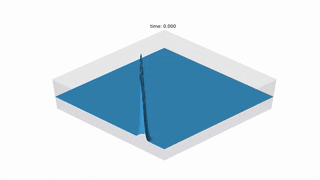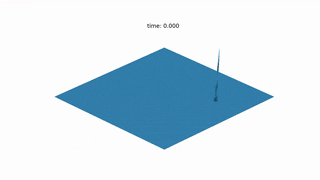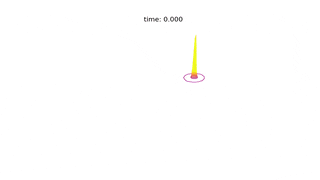A CFD python package for the shallow water equations
Project description
MattFlow
A CFD python package for the shallow water equations.
MattFlow simulates the surface of the water after any initial conditions, such as drops or stones falling on.


| requirements | os |
|---|---|
| python 3 | GNU/Linux |
| numpy >= 1.16.4 | Windows |
| matplotlib >= 3.1.1 | |
| jpblib >= 0.13.2 | |
| ffmpeg (optional) |
How to install & run MattFlow
- anaconda environment (recommended)
$ conda create --name mattflow python=3 matplotlib
$ conda activate mattflow
$ pip install mattflow
$ mattflow
- venv (python>=3.3)
$ python3 -m venv mattflow_env
$ source mattflow_env/bin/activate
$ pip install mattflow
$ mattflow
- pip
$ pip install --user mattflow joblib
$ mattflow
Swallow Water Equations
SWE is a simpified CFD problem which models the surface of the water, with the assumption that the horizontal length scale is much greater than the vertical length scale.
SWE is a coupled system of 3 hyperbolic partial differential equations, that derive from the conservation of mass and the conservation of linear momentum (Navier-Stokes) equations, in case of a horizontal stream bed, with no Coriolis, frictional or viscours forces (wiki).
![{\displaystyle {\begin{aligned}{\frac {\partial (\rho \eta )}{\partial t}}&+{\frac {\partial (\rho \eta u)}{\partial x}}+{\frac {\partial (\rho \eta v)}{\partial y}}=0,\\[3pt]{\frac {\partial (\rho \eta u)}{\partial t}}&+{\frac {\partial }{\partial x}}\left(\rho \eta u^{2}+{\frac {1}{2}}\rho g\eta ^{2}\right)+{\frac {\partial (\rho \eta uv)}{\partial y}}=0,\\[3pt]{\frac {\partial (\rho \eta v)}{\partial t}}&+{\frac {\partial (\rho \eta uv)}{\partial x}}+{\frac {\partial }{\partial y}}\left(\rho \eta v^{2}+{\frac {1}{2}}\rho g\eta ^{2}\right)=0.\end{aligned}}}](https://pypi-camo.freetls.fastly.net/77f50493bb2f3d76b02a43b8d6e9c6657901e342/68747470733a2f2f77696b696d656469612e6f72672f6170692f726573745f76312f6d656469612f6d6174682f72656e6465722f7376672f39623964343831343037633063383335353235323931373430646538643163343436323635636532)
where: η : height u : velocity along the x axis υ : velocity along the y axis ρ : density g : gravity acceleration
MattFlow structure
More details at this jupyter notebook
- configuration of the simulation via a config file
- pre-process structured/cartesian mesh
- solution
supported solvers:
- Lax-Friedrichs Riemann | O(Δt, Δx2, Δy2)
- 2-stage Runge-Kutta | O(Δt2, Δx2, Δy2) | default
- MacCormack | O(Δt2, Δx2, Δy2) | experimental
- post-processing matplotlib animation
Additional configurations
- mesh sizing
- domain sizing
- initial conditions (single drop, multiple drops, rain)
- boundary conditions (currently: reflective)
- solver
- multiprocessing
- plotting style
- animation options
Currently, you can configure the simulation at the config module
TODO
- coverage hooks
- API
- Numba
- Higher order schemes
- Addition of source terms
- Addition of viscous models
- Algorithm that converts every computational second to a real-time second, playing with the fps at the post-processing timelapse, because each iteration uses different time-step (CFL condition)
- Moving core to C++ or Cython?
- Moving objects inside the domain
- Unstructured mesh
- Extent to 3D CFD
Start the flow!
(C) 2019, Thanasis Mattas atmattas@physics.auth.gr
Project details
Release history Release notifications | RSS feed
Download files
Download the file for your platform. If you're not sure which to choose, learn more about installing packages.












